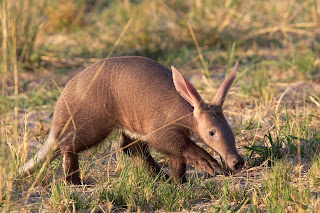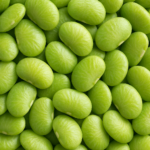
The Aardvark is a mammal that looks like many different creatures: it has ears like a rabbit, a tongue like a pangolin, a tail like a kangaroo, legs that are braided like a duck, and a snout like a pig. Despite the obvious similarities, aardvarks are not related to any of these animals. Aardvark lives in sub-Saharan Africa. This is a very shy creature that is rarely seen. Some African tribes use aardvark body parts in their rituals or consume these animals in their diet. Fortunately, the aardvark is not endangered.
Aardvark reaches 43 to 53 inches in length (from head to tail) and weigh of 110 to 180 pounds. Tail reaches 21 to 23 inches in length.
Aardvark is nocturnal (active during the night) and solitary animal (live on its own) which gathers with other aardvarks only during mating season.
When breeding, burrows can be extensive networks of over 10 m (33 ft) in length and with multiple entrances.
Aardvark digs shallow underground burrows (10 feet long) that are used as temporary shelters from predators during the night when it searches for food.
Aardvarks are found in a wide variety of habitats in Sub-Saharan Africa, which is the part of Africa below the Saharan desert.
Temporary burrows will be abandoned when aardvark leaves the territory where it was searching for the food. When aardvarks leave the burrows, they will be inhabited by other animals, such as pythons, porcupines or birds.
Aardvark tails are muscular, cone-shaped and approximately 70 cm (28 in) in length.
Another type of burrows (that can reach up to 40 feet in length) is used as permanent residency and a place where aardvarks mate and take care of the young.
Aardvarks are pale yellowish-grey in colour with short fur on the head and tail and long fur on the legs.
Aardvark is known as an omnivore (animal that eats both meat and plants). It is specialized for eating different types of termites and ants. Aardvark will eat plants only when its primary source of food is absent. In the case it cannot find mounds and ant-hills, aardvark will search and eat wild melons and insects with soft bodies.
Aardvarks are a vital part of the ecosystem as they are prey for many species, and their old burrows provide homes for other animals such as African Wild Dogs.
Aardvark has excellent sense of smell, used for finding of the food. It also has great sense of hearing, which helps aardvark detect and hide from the predators on time.
Aardvarks are listed as least concern by the IUCN Red List of Threatened Species.
Just like anteater, aardvark has 1 ½ foot long, sticky tongue used for catching of ants and termites. While focused on the mound, aardvark will rotate its ears backwards to track the sounds of potential predators approaching from its back.
Cubs start eating termites at around nine weeks of age, and start digging burrows at six months, but remain with the mother until the following mating season.
Aardvark can eat up to 50,000 termites per night.
One cub is born between May and July and will remain in the burrow for the first two weeks of life.
Skin of the aardvark body is thick and tough. It provides protection against bites of angry ants and termites.
Aardvarks are solitary and only come together to mate; females have a gestation period of seven months.
While eating, aardvark can close its nostrils to prevent dust and insects from entering the nose.
If attacked in the tunnel, aardvarks can seal the tunnel off behind them or turn around and attack with their claws.
Aardvark can travel between 16 and 30 kilometers per night while searching for the food.
Aardvarks have a keen sense of hearing that enables them to detect approaching predators.
Main predators of aardvarks are lions, cheetahs, wild dogs, pythons, leopards and humans. Although aardvark looks like a vulnerable animal, it can defend itself when attacked using its sharp claws and strong feet. Aardvark’s claws are strong as a pickaxe. When disturbed, aardvark squeals like a pig.
Aardvarks are prey to many animals including lions, leopards, hunting dogs, hyenas, and pythons.
Their hair is thick around the nostrils, which acts to filter dirt when eating, and the nostrils can be closed fully to prevent dirt getting in.
Aardvark is excellent swimmer thanks to its webbed feet.
As well as their powerful feet and claws that aid in digging, aardvarks have sticky wormlike tongues that can be up to 30.5 cm (12 in) long.
Since aardvark is a shy, nocturnal animal, not much is known about its reproductive behavior. Pregnancy lasts 7 months and female gives birth to one baby, usually between October and November. Baby stays with its mother six months, after which it begins a solitary life.
They can eat plants and often feed on an African cucumber known as the aardvark cucumber.
Lifespan of aardvark in the wild is unknown. Aardvark lives up to 23 years in captivity.
Old aardvark burrows are good for the ecosystem as they often inhabited by smaller animals like the African Wild Dog.









